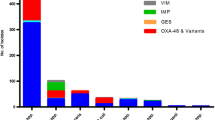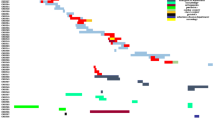Abstract
Carbapenem-hydrolyzing β-lactamases are increasingly reported worldwide, leading to therapeutic failure. In an era where the drug development pipeline is stagnant, it is crucial to preserve current classes of antibiotics to help fight against infection caused by multidrug-resistant organisms (MDROs), by practicing a rational approach for the use of antibiotics. Identifying the mechanisms of resistance gives us much needed insights in this field. A total of 113 consecutive, non-duplicate carbapenem-resistant clinical isolates were collected from July to December 2012. These isolates were subjected to the modified Hodge test (MHT) for phenotypic detection of carbapenemases, an inhibitor-based test employing EDTA for the detection of metallo-β-lactamase (MBL), and phenylboronic acid for the detection of Klebsiella pneumoniae carbapenemase (KPC). A multiplex polymerase chain reaction (PCR) assay that characterized the five most predominant carbapenemases (bla NDM, bla OXA, bla VIM, bla IMP, bla KPC) was designed. The 113 isolates consisted of Klebsiella spp. (46), Enterobacter spp. (32), Escherichia coli (31), Citrobacter spp. (2), Proteus spp. (1), and Morganella spp. (1). bla NDM-1 was the most prevalent carbapenemase and accounted for 75.22 % (85/113) of the isolates. This was followed by bla OXA [4.42 % (n = 5)]. 18.5 % (21/113) of the isolates possessed dual carbapenemase genes. 98.9 % concordance was observed between the phenotypic tests and the molecular tests for the detection of MBL. In conclusion, patients infected with resistant bacteria require early appropriate antimicrobial treatment for good clinical outcome. Thus, identifying the resistant mechanisms of suspected pathogens becomes crucial. Also, the high incidence of plasmid-mediated bla NDM-1 calls for the implementation of strict infection control and contact isolation precautions in order to prevent the spread of these organisms.



Similar content being viewed by others
Abbreviations
- MDRO:
-
Multidrug-resistant organism
- MBL:
-
Metallo-β-lactamase
- PBA:
-
Phenylboronic acid
- CLSI:
-
Clinical and Laboratory Standards Institute
- CDT:
-
Combined disk test
References
Tenover FC (2006) Mechanisms of antimicrobial resistance in bacteria. Am J Med 119(6 Suppl 1):S3–S10
Papp-Wallace KM, Endimiani A, Taracila MA, Bonomo RA (2011) Carbapenems: past, present, and future. Antimicrob Agents Chemother 55(11):4943–4960
Bush K, Jacoby GA (2010) Updated functional classification of β-lactamases. Antimicrob Agents Chemother 54(3):969–976
Nordmann P, Naas T, Poirel L (2011) Global spread of carbapenemase-producing Enterobacteriaceae. Emerg Infect Dis 17(10):1791–1798
Upadhyay S, Sen MR, Bhattacharjee A (2012) Identification and characterization of carbapenem hydrolysing β-lactamase—KPC among enterobacteriaceae: a report from North India. Asian J Med Sci 3:11–15
Queenan AM, Bush K (2007) Carbapenemases: the versatile β-lactamases. Clin Microbiol Rev 20(3):440–458
Birgy A, Bidet P, Genel N, Doit C, Decré D, Arlet G et al (2012) Phenotypic screening of carbapenemases and associated β-lactamases in carbapenem-resistant Enterobacteriaceae. J Clin Microbiol 50(4):1295–1302
Clinical and Laboratory Standards Institute (CLSI) (2012) Performance standards for antimicrobial susceptibility testing; twenty-second informational supplement. CLSI document M100-S22
Galani I, Rekatsina PD, Hatzaki D, Plachouras D, Souli M, Giamarellou H (2008) Evaluation of different laboratory tests for the detection of metallo-beta-lactamase production in Enterobacteriaceae. J Antimicrob Chemother 61(3):548–553
Tsakris A, Poulou A, Pournaras S, Voulgari E, Vrioni G, Themeli-Digalaki K et al (2010) A simple phenotypic method for the differentiation of metallo-β-lactamases and class A KPC carbapenemases in Enterobacteriaceae clinical isolates. J Antimicrob Chemother 65:1664–1671
Deshpande P, Rodrigues C, Shetty A, Kapadia F, Hedge A, Soman R (2010) New Delhi metallo-b lactamase (NDM-1) in Enterobacteriaceae: treatment options with carbapenems compromised. J Assoc Physicians India 58:147–149
Lahey Clinic. Home page at: http://www.lahey.org/Studies
Datta P, Gupta V, Garg S, Chander J (2012) Phenotypic method for differentiation of carbapenemases in Enterobacteriaceae: study from north India. Indian J Pathol Microbiol 55(3):357
Nordmann P, Poirel L (2013) Strategies for identification of carbapenemase-producing Enterobacteriaceae. J Antimicrob Chemother 68(3):487–489
Doyle D, Peirano G, Lascols C, Lloyd T, Church DL, Pitout JD (2012) Laboratory detection of Enterobacteriaceae that produce carbapenemases. J Clin Microbiol 50(12):3877–3880
Gençer S, Ak O, Benzonana N, Batirel A, Ozer S (2002) Susceptibility patterns and cross resistances of antibiotics against Pseudomonas aeruginosa in a teaching hospital of Turkey. Ann Clin Microbiol Antimicrob 1:2
Picão RC, Andrade SS, Nicoletti AG, Campana EH, Moraes GC, Mendes RE et al (2008) Metallo-β-lactamase detection: comparative evaluation of double-disk synergy versus combined Disk tests for IMP-, GIM-, SIM-, SPM-, or VIM-producing isolates. J Clin Microbiol 46(6):2028–2037
Franklin C, Liolios L, Peleg AY (2006) Phenotypic detection of carbapenem-susceptible metallo-beta-lactamase-producing gram-negative bacilli in the clinical laboratory. J Clin Microbiol 44(9):3139–3144
Yong D, Toleman MA, Giske CG, Cho HS, Sundman K, Lee K et al (2009) Characterization of a new metallo-beta-lactamase gene, blaNDM-1, and a novel erythromycin esterase gene carried on a unique genetic structure in Klebsiella pneumoniae sequence type 14 from India. Antimicrob Agents Chemother 53:5046–5054
Bharadwaj R, Joshi S, Dohe V, Gaikwad V, Kulkarni G, Shouche Y (2012) Prevalence of New Delhi metallo-β-lactamase (NDM-1)-positive bacteria in a tertiary care centre in Pune, India. Int J Antimicrob Agents 39(3):265–266
Jovcic B, Lepsanovic Z, Suljagic V, Rackov G, Begovic J, Topisirovic L et al (2011) Emergence of NDM-1 metallo-β-lactamase in pseudomonas aeruginosa clinical isolates from Serbia. Antimicrob Agents Chemother 55(8):3929–3931
Livermore DM (2012) Current epidemiology and growing resistance of gram-negative pathogens. Korean J Intern Med 27:128–142
Poirel L, Potron A, Nordmann P (2012) OXA-48-like carbapenemases: the phantom menace. J Antimicrob Chemother 67(7):1597–1606
Poirel L, Héritier C, Tolün V, Nordmann P (2004) Emergence of oxacillinase-mediated resistance to imipenem in Klebsiella pneumoniae. Antimicrob Agents Chemother 48(1):15–22
Acknowledgments
We thank Dr. Anand Manoharan, Christian Medical College (CMC), Vellore for providing us with bla VIM- and bla IMP-positive controls, and Dr. Rajni Gaind, Consultant Microbiologist, Vardhman Mahavir Medical College (VMMC) and Associated Safdarjung Hospital, New Delhi for providing us with the bla KPC-positive control.
Funding
The project was funded by the National Health and Education Society.
Conflict of interest
None to declare.
Author information
Authors and Affiliations
Corresponding author
Rights and permissions
About this article
Cite this article
Kazi, M., Drego, L., Nikam, C. et al. Molecular characterization of carbapenem-resistant Enterobacteriaceae at a tertiary care laboratory in Mumbai. Eur J Clin Microbiol Infect Dis 34, 467–472 (2015). https://doi.org/10.1007/s10096-014-2249-x
Received:
Accepted:
Published:
Issue Date:
DOI: https://doi.org/10.1007/s10096-014-2249-x




